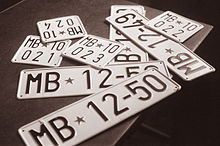License plate (Slovenia)
Slovenian license plates were introduced in 1992, one year after the split from Yugoslavia .
layout
The license plates consist, from left to right, of two letters that indicate the district, the municipal coat of arms and a block of numbers and letters with a hyphen. Until Slovenia joined the European Union on May 1, 2004, the signs had a green frame. In 2004, a blue bar with the twelve European stars and the country code SLO was added to the left. At the same time the font was changed. Since 2009, the license plates of Slovenia have been issued with a green instead of the black frame, which has been valid since the introduction of the EU license plates.
Desired license plate
Optional license plates are available in Slovenia for an extra charge , in which the combination according to the coat of arms can be freely selected.
Identification types
Two-wheelers
Motorcycles have two-line plates that look like normal license plates. Yellow, three-line license plates are used for mopeds. They show the EU bar in the top left corner, then the district code and the municipality's coat of arms. Lines two and three are followed by a combination of letters and numbers.
pendant
Trailers receive the same number plates as cars. Until 2008, the order of the units was exactly the opposite. They began with the letter-number combination and ended with the district abbreviation after the coat of arms. The reversal of the combination for the trailer license plates was taken over from the Yugoslav license plate system and can only be found in Serbian license plates .
License plates for agricultural vehicles
Agricultural vehicles have license plates with white letters on a dark green background.
Temporary license plates
Temporary license plates are similar to normal license plates and also show a year on the right-hand edge by means of two superimposed digits. Until 2004, they had a light green background.
Trial license plate
Test marks either show the word PREIZKUŠNJA above the font or the letters PR within a vertical red bar.
Export indicator
Vehicles that are to be exported from Slovenia are given yellow license plates. They show two black fields on the right-hand side with details of the month and year of validity. Red font was used for these signs until 2008.
Police license plate
Characteristic of the Slovenian police show blue characters and begin with the letter P . This is followed by the coat of arms of the Slovenian police and five digits in two groups.
Diplomatic plates
Diplomatic license plates begin with the green letters CMD for an ambassador , CD for diplomats in general, CC for consuls or M for members of the embassy without diplomatic status . This is followed by a two-digit black number that indicates the country of origin, followed by further distinguishing numbers. After independence, the diplomatic shields were still similar to those of Yugoslavia. They were black with yellow inscription. The district abbreviation appeared at the beginning, followed by two digits to encode the country of origin. A letter then indicated the status of the vehicle. After a serial number, the year of validity appeared written one above the other. These black plates were replaced by orange ones in 1996 until the current license plates were finally issued in 2000.
Military license plate
License plates of the Slovenian Armed Forces show a black background and begin with the letters SV for sloven. Slovenska Vojska (German Slovenian Army ). This is followed by the army's coat of arms and a two-digit number from which the origin can be read. The sign ends with a combination of numbers. Until 1997, license plates with the abbreviation TO for Teritorialna obramba (territorial defense ) were used according to the same pattern .
District abbreviation
The district abbreviations (with the German names and the recognized minority names in brackets) are:
- CE Celje ( Cilli )
- GO Nova Gorica ( New Gorizia , Italian Nuova Gorizia )
- KK Krško ( Gurkfeld )
- KP Koper ( Gafers , Italian Capodistria , Croatian Kopar )
- KR Kranj ( Krainburg )
- LJ Ljubljana ( Ljubljana )
- MB Maribor ( Marburg an der Drau )
- MS Murska Sobota ( Olsnitz , Hungarian Muraszombat )
- NM Novo mesto ( Rudolfswerth )
- PO Postojna ( Adelsberg , Italian Postumia )
- SG Slovenj Gradec ( Windischgrätz )
This system was taken over from the Yugoslav era, although these districts (originally from the old Austrian era) no longer exist from an administrative point of view since the independence of Slovenia and only live on on the license plates and with the regional command structure of the Slovenian police .
The following assignments apply to military license plates:
- 01 - Ljubljana
- 02 - Maribor
- 03 - Novo Mesto
- 04 - Murska Sobota
- 05 - Kranj
- 06 - Postojna
- 07 - Koper





